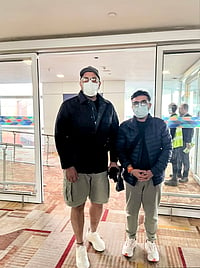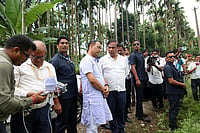Parts of the national capital reeled under a cold wave on Tuesday as its minimum temperature fell below that of hill stations Dharamshala and Nainital.
With a high windchill factor -- a measure of the rate of heat loss from the skin that is exposed to the air -- in play, cold day conditions prevailed in some parts of the city such as Palam and Jafarpur.
A cold day is when the minimum temperature is less than or equal to 10 degrees Celsius below normal and the maximum temperature is at least 4.5 degrees below normal. A severe cold day is when the maximum is 6.5 degrees or more below normal.
The Safdarjung observatory, Delhi's primary weather station, logged a minimum temperature of 5.6 degrees Celsius -- a notch below normal. The maximum temperature settled at 17.2 degrees Celsius, three notches below normal.
In comparison, the minimum temperature in Dehradun was recorded at 7 degrees Celsius, Dharamshala at 6.2 degrees Celsius, and Nainital at 7.2 degrees Celsius.
Meteorologists attributed the sharp drop in day temperatures to frigid north-westerly winds barrelling through the plains and reduced sunshine due to foggy weather.
Mahesh Palawat, vice president (meteorology and climate change), Skymet Weather, said a western disturbance led to a fresh spell of snowfall in the mountains on December 25-26 and cold northwesterly winds are now sweeping through the plains after its retreat.
He said the wind chill factor was also high.
Palawat said coldwave conditions in northwest India would abate from Wednesday under the influence of a fresh western disturbance. However, the relief is likely to be short-lived.
The sun was blotted out in large swathes of northwest India as a dense to very dense fog prevailed in some parts of the National Capital Region, Haryana, Punjab, west Uttar Pradesh, and north Rajasthan.
In the national capital, visibility fell to just 50 metres and affected road traffic and train movement. An intense cold wave gripped the entire Himachal Pradesh as minimum temperatures dropped to freezing point at most places.
The minimum temperatures dipped 10-12 degrees below freezing point in high altitude tribal areas, mountain passes, and other higher ranges, while several other places reeled under lower reaches of sub-zero temperature.
Keylong in tribal Lahaul valley recorded minus 7.9 degrees, followed by Kusumseri minus 5.0 degrees, Kalpa minus 3.6 degrees, Manali minus 0.6 degrees, and Bhuntar minus 0.4 degrees.
Solan and Shimla recorded a minimum of 2.3 and 4.5 degrees Celsius, in that order. The cold wave conditions are likely to continue, according to the weather department.
The local MeT office has predicted light rainfall at isolated places in lower, mid, and higher hills on Thursday and rains at isolated places and in mid-hills and rains or snow at isolated places in higher hills on Friday.
Fog shrouded many parts of Punjab and Haryana where intense cold weather conditions continued on Tuesday.
In Haryana, Narnaul shivered at 1 degree Celsius, four degrees below normal, according to a report of the Met centre here. In Punjab, Bathinda experienced cold weather conditions at 1.4 degrees Celsius. Amritsar recorded a low of 5 degrees Celsius while Ludhiana's minimum was 6.6 degrees Celsius.
Severe cold conditions prevailed in Rajasthan as well. However, the regional weather office has predicted the possibility of a slight increase in the minimum and maximum temperatures from Wednesday.
Coldwave conditions also crippled Kashmir as the mercury fell by a couple of degrees across the Valley to push the minimum temperature further below freezing point, officials said.
The minimum temperature on Monday night fell further down by 1-2 degrees compared to the previous night.
The intense cold led to water supply lines freezing in several areas. The interiors of Dal Lake and several other water bodies in the Valley also froze, the officials said.
The minimum temperature in Srinagar settled at minus 4.8 degrees Celsius -- down from minus 3.5 degrees Celsius on Sunday night.
According to the India Meteorological Department (IMD), 'very dense' fog is when visibility is between 0 and 50 metres, 51 and 200 metres is 'dense', 201 and 500 'moderate', and 501 and 1,000 'shallow'.
In the plains, the IMD declares a cold wave if the minimum temperature dips to four degrees Celsius or when the minimum temperature is 10 degrees Celsius or below and is 4.5 notches below normal.
A 'severe' cold wave is when the minimum temperature dips to two degrees Celsius or the departure from normal is more than 6.4 degrees Celsius.


























